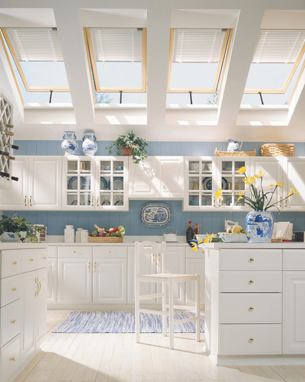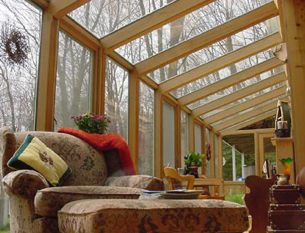How Does Passive Solar Work?

Roof Window Used In Passive Solar Design
The main goal of any green home design is to minimize the amount of energy used to heat, cool and power it. Fossil fuels such as coal, natural gas, and fuel oil all produce pollution, and all release carbon dioxide, a leading cause of climate change.
Energy from nuclear power doesn't emit carbon emissions but has a host of issues all its own, such as radioactive waste storage and the possibility of a nuclear accident like a meltdown. Satisfying energy needs with renewable energy from the sun, wind, or water will reduce pollution as well as save money in the long term.
A well-designed green home, in addition to minimizing its overall use of energy, can incorporate renewable energy to satisfy some or all of its' energy needs without producing CO2 emissions.
A direct and elegant way to make use of renewable energy is called Passive Solar Energy. Passive solar design uses the windows, walls, floors and directional orientation of the house itself to collect, store, and distribute energy from the sun in the form of heat in the winter (solar heating) and rejecting it in the summer (solar cooling) and light. It is called passive because unlike 'active' solar systems such as photovoltaics, there are no mechanical or electrical devices used; the structure itself does the work of collecting and distributing the solar energy.
How Does Passive Solar Work:? - Passive Solar Design
While the passive solar home will save energy and money over time through lower heating and cooling bills, it will cost more to design and is where the additional investment is made.
Careful design and computer modeling are imperative for a passive solar home design to maximize its potential.
How Does Passive Solar Work? - Types of Passive Solar Design
Suntempering
There are several different types of passive solar home design. The simplest way to use the sun's energy is known as suntempering to heat a house.
With suntempering, no special design is necessary other than orienting the house so that a longer wall with more windows faces south to capture the sun's energy. While a suntempered house won't collect enough heat to replace other sources, heating costs can often be reduced by up to 10%.

Sun Rooms Are Another Great Solar Gain Element
Direct Gain Passive Solar Heating
The most common type of passive solar heating is known as a direct gain system, and is the one that requires the most attention to design in order to maximize solar heating potential. Basically, the house is designed so that the sun warms a space directly during the daytime hours.
Some of that heat is absorbed into the walls and floor of the house and then released over time to warm the house at night. This is done through the use of high-mass materials such as concrete slab flooring and brick interior wall facings. The building itself collects the solar energy, stores it, and distributes it without the use of any fans or pumps.
Sunspace (Isolated-Gain) Passive Solar Heating
Another type of passive solar heating is a sunspace. This is a separate room on the south-facing side of a house with lots of windows which heats up during the day, collecting the sun's energy. A door, window or vents between the sunspace and house are opened during the day, allowing that heat to circulate into the house, then closed at night when the temperature in the sunspace drops. This is also known as an isolated-gain system since the heated space is separated from the living space.
How Does Passive Solar Work? - Passive Solar Cooling
While a good design can be used to capture the sun's energy to heat a house, it can (and should) also be used to keep a house cooler in warmer months without the need for air-conditioning.
Keeping windows to no more than 10% of the floor area on the south-facing wall and reducing the area of east and west facing windows will avoid overheating, and reduce air conditioning costs in warmer months.
Careful selection of windows and their positioning in the house, as well as the use of ceiling fans, can greatly increase the natural ventilation of a home. Shading through the use of roof overhangs, window awnings, shades and landscaping can block the sun's heat during the summer months while allowing it to enter the home during the winter.
It is important to remember that proper insulation will go a long way to helping a home stay warm or cool and increase the effectiveness of a home's passive solar design.

Use of Light Shelves To Bounce Sunlight Into Sapces
How Does Passive Solar Work? - Daylighting
Another simple way to take advantage of solar energy is to design the home to provide for lots of natural daylight, using sunlight instead of electric lighting during the day. This is done through the thoughtful use and placement of windows, skylights, and tubular skylights.
Skylights and windows provide lots of natural light, but care should be taken to choose products that have high performance, low-solar-heat-gain glazings that will minimize heat gain during warmer months, especially on southern-facing windows. Tubular skylights are a newer type of skylight.
Tubular skylights are round skylights mounted on the roof connected by reflective tubes through attics, providing light to rooms below. Tubular skylights look like regular ceiling light fixtures, and can provide the light of several 100-watt incandescent light bulbs.
A well-thought out green home plan will incorporate many, if not all, of these concepts into its design to minimize the use of non-renewable resources to keep heating and cooling costs down over the life of the home.
comments powered by Disqus

























































































































































































